Don't wanna be here? Send us removal request.
Text
Duelpad Zen 16 Review: a carefully considered controller for fighters, rhythm games and more

by Amr (@siegarettes)
A review unit was provided by Duelpad for this review.
The Duelpad Zen 16 isn't going to surprise you. It's familiar in terms of features and build quality, and it easily fits in with the family of budget fighting game controllers saturating the market right now. It's the same acrylic sandwich design, with the same strip prone Chicago screws, running the same open source GP2040CE firmware.
What makes it stand out are the small details that show careful consideration. The corners have been extended to make room for your wrists, button rims surround the keycaps to create a feeling closer to traditional arcade buttons, without compromising the hot swap functionality. The OLED status screen sports a small navigation cluster that can be used to configure options without a computer, and it rocks a split layout with extra button placements that actually make sense.

The split layout is my personal headliner, combining a WASD style directional cluster, with a set of thumb buttons that make it a viable option not only as a fighting game controller, but a controller replacement.
GP2040CE supports up to 4 remappable layouts, so you can swap between layouts that support different games.

For 2D fighting games I keep the two large thumb buttons as jump, keeping the advantages of a traditional Hitbox layout, while allowing a more relaxed posture with more space between the movement and action buttons, and the smaller thumb buttons still free for extra functions.

For other games I leave the WASD cluster as my main movement, with the thumb buttons replacing the shoulder buttons, triggers, or thumbstick clicks, leaving the pinky column on the action buttons free for additional functions and modifiers.
For example, here I've mapped the thumb buttons to the shoulders and triggers, leaving the 4 face buttons in the first two columns, followed by the L3 and R3 buttons, with the pinky column used to switch the directionals to dpad and right stick movements.
It works for both 2D and 3D games, as long as they don’t rely on the right stick for aiming or frequent camera adjustments.
In Mega Man 11 I used this setup to quickly switch weapons with the right stick, leaving two extra buttons available to map shortcut buttons. In DMC4 this allows me to quickly perform multi-button maneuvers while charging projectile weapons, and quickly adjust the camera or switch styles by using the modifiers.
You can even set up dual stick setups, for twin stick arcade games or rhythm games. In Project Diva you can mirror the WASD setup with the face buttons, while in Theatrhythm you can control both sticks on the action and movement buttons, with the thumb buttons available for drumming out notes.
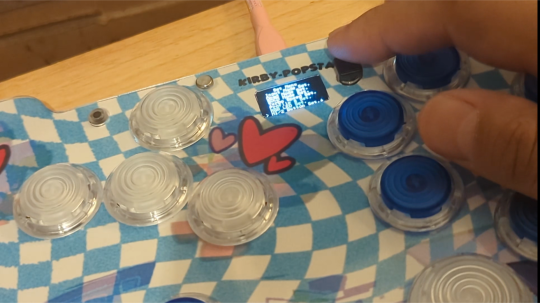
Let’s talk about that OLED. These tiny screens are quickly becoming a killer feature of modern controllers, allowing you to easily check your buttons and settings. The Duelpad Zen takes this one step further and allows you to change the settings directly on the screen itself. What I initially assumed was an extra button turned out to be a full navigation cluster, allowing you to cycle through various settings from an on board menu, without the need to connect it to a computer. You can change the console mode, dpad settings, RGB lighting and even the extra button mappings through the menu, saving you from memorizing several shortcuts for each function.
In its current state, it’s unfortunately a bit finicky. At least with my configuration, the menu seems to only operate when I’m in the first profile, and frequently freezes after swapping to another profile, until restarted.
On the opposite side of the menu are the RGB underglow controls. With them you can cycle through the various lighting modes, though they seem to be controlled separately from the rest of the controller, with no dynamic modes that react to button presses. The topside RGB can be controlled through the menu or web config, with a lot more flexibility for customization.
The problem is that these LEDs are blindingly bright, with even the lowest of the three settings being bright enough to distract you from your game. I can’t see these as useful for anything except blinding your opponent.

In terms of other customization, the dense layout doesn’t leave much room for art in the center, but the sides provide ample space for details. A paper layer is pre-installed in the controller, and makes a good template for cutting out your own art should you choose to do it by hand, like I did.
The Duelpad Zen 16 has plenty of small issues that give a sense of jank to what’s otherwise a well considered device. But none of these issues got in the way when it was time to play. Setting up could be troublesome, but once I dialed in my settings and got into a game, the Zen was rarely less than a joy to play with.
The layout is well spaced and comfortable, the button rims add a sense of stability other controllers lack, and the quiet, fast response switches translated inputs with satisfying feedback. Whether I played fighting games, platformers, or rhythm games, the Zen felt up to the task. With its novel form factor and button layout, I can easily see it staying in my controller rotation, even with many more high end competitors.
2 notes
·
View notes
Text
Arkodd Padbox Review: a fightpad for the arcade afficionado

by Amr (@siegarettes)
Sporting a clicky dpad and an enclosure large enough to accommodate 24mm arcade buttons, the Arkodd Padbox is a controller/fightstick hybrid set to fill the niche left by a lack of good 6 button fightpads.
The dpad is equipped with Omron mechanical switches, similar to the ones used in arcade sticks, and a left shoulder button and additional thumb button complement the standard 8 button layout, allowing access to extra functions and alternative button placements.

The Padbox comes as fully assembled units or DIY kits that include the case, dpad, wiring and function buttons. For this review I opted for the DIY kit, since I wanted to see what the build process was like, and customize the build with parts I had on hand.
Full disclosure: I was sent this kit to review, but I wasn’t given any instructions or limitations on what I could say.
With that out of the way, what immediately impressed me was how easy the build process was. The Padbox comes apart with only a few screws, and the dpad, shoulder button and aux buttons are already pre-installed. The wiring harnesses provided are sized appropriately for the available space, and headers for the dpad and shoulder buttons, alongside pre-made dupont connectors made wiring them to the screw terminals simple.

If there’s one thing to note it’s that the Padbox uses a direct USB connection for its USB C jack, rather than the Neutrik Type-D passthrough ports that many custom fightstick builds use. The connector is designed with Brook Fighting Boards in mind, which have pre-populated headers for USB, but I opted to use a RP2040 Advanced Breakout Board I had on hand to get access to the advanced features of GP2040ce. If you do goes this way, make sure you get the latest version of the board with the screw terminals for the extra functions, as those have pre-populated USB headers, otherwise you’ll have to solder on your own like I did.
You’ll also need to plug into the 5v VCC terminal for the power indicator LED, though if you are somehow doing an even more niche build of a niche product, and using a Brook Wireless board for it, you’ll need to connect to the player indicator LEDs instead, since the 5v terminal won’t output when running on battery.
Aside from these incredibly niche considerations, the overall build process is fast and painless. I built it all on a weeknight after work, and I even had time to stickerbomb it and test out a few games with it. I’ve had a harder time modding some fully built fightsticks.
Now the most important question: how’s the dpad. In short: they nailed it. No matter what style of game I played it was easy to get my inputs out, with no accidental inputs. After using so many controllers and handhelds, I can tell you this is a hell of an accomplishment. Even mechanical dpads aren’t a silver bullet to this problem, as I’ve seen so many of them with the same kind of satisfying feedback that are miserable in practice. So I’m happy to report that this dpad is not one of them.
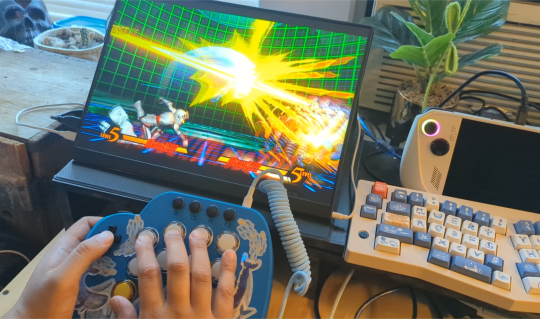
One of the first games I tried the Padbox with was Ultimate Marvel vs Capcom 3’s trial mode, my go to for testing new fighting game controllers. Here it performed better than basically any first party controller dpad, with the combo of the microswitch dpad and larger arcade buttons making it easy to get in rhythm. The same happened in Street Fighter 6, where the extra buttons allowed me to access Drive Functions easier than the standard 8 button layout, and the shoulder button provided comfortable access to the assist function for characters I play with Modern Controls.
For anyone who plays primarily on pad, I could definitely see this as an upgrade to a regular gamepad or fightpad, especially for those who play claw grip and wouldn’t miss the extra shoulder buttons. With the swappable buttons, an all mechanical controller is even possible, given the growing options for buttons with keyboard style switches.
Personally, the Padbox won’t likely stay in rotation for playing fighting games, despite how much I like it. The Padbox can’t solve the fundamental problem I have with playing fighting games on pad: it’s too cramped. As someone particularly sensitive to this issue, I find that putting all the strain on my thumb wears me down faster when performing complex inputs, and the Padbox made it clear that for me, no pad can compete with the comfort of leverless for competitive games.
But who says you can only use a fighting game controller for fighting games?
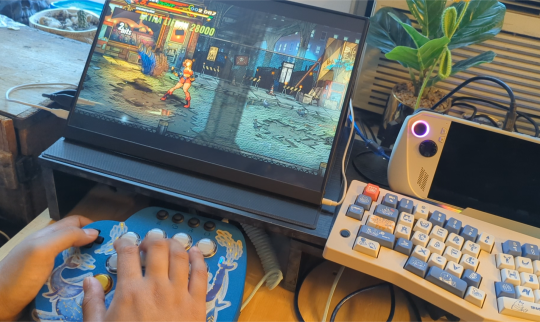
Arcade buttons are plenty of fun across multiple genres, and with its hybrid design, the Padbox enables a variety of approaches that both traditional fightsticks and pads can’t provide. I tested it with beat-em-ups like Streets of Rage 4 and Shredder’s Revenge, where the arcade layout made performing combos a joy.

Retro consoles and throwback games are another good candidate, with the tactile feedback a the Padbox’s dpad a definite upgrade to a lot of the membrane dpads and buttons of original controllers, with the bonus of arcade buttons being a lot more fun to mash in the many games that demanded it.
Action games that make limited use of the right stick for camera control are totally playable with the Padbox, and with the use of GP2040ce, you can even use the extra buttons to create modifiers that give you on the fly access to the dpad or right stick for item hotkeys or camera control.
I even managed to make a playable control scheme for Smash Bros Ultimate, complete with c-stick buttons for tilt and aerial attacks.
The Padbox might not be my personal choice for serious fighting game competition, but it’ll definitely stay in rotation as one of my alternative controllers for casual fighting, and playing plenty of other genres.
If there's any additions I'd like to see, it's the addition of additional shoulder and thumb buttons. These would not only give access to an extra shortcut button in fighting games, but enable layouts with extra functions or modifiers, such as tilt modifiers or dual directional input in the style of the Hitbox Crossup.
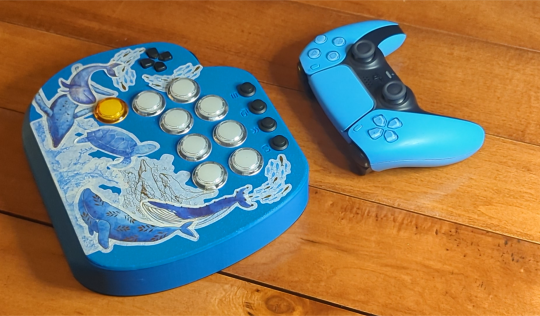
The Padbox is also a bit lightweight. It comes in a little heavier than a standard controller, but it's spread out across a larger surface area, and alongside the slickness of the 3D printed material, it threatens to slip during those literally sweaty matches. An optional metal bottom plate or a removable weight for the grip might help give it heft for longer play sessions and lap play.
My favorite part of the Padbox has to be how many possibilities it leaves open. With its form factor, it's easy to start thinking of new ways to mod the Padbox and make it your own. It brings the DIY spirit of arcade sticks to a pad, and I've already seen wild molds replacing the dpad with a split dpad, or building entire new bases for it and adding more buttons.
If you're a controller enthusiast looking for a good fightpad, or just something with a real good dpad, consider giving the Padbox a look.
2 notes
·
View notes
Text
Shadow of the Ninja Reborn is a tremendous neo-retro game with the art and quirks to match

by Amr (@siegarettes)
Developer: NatsumeAtari
Publisher: NatsumeAtari, Edigger, United Games Entertainment GmbH
Returning after 30 years to revisit their original work, Tengo Project have once again proven the kind of mastery they’ve achieved with decades of experience. Tengo Project’s previous efforts built on Super Famicom works that were impressive in their own right, but with Shadow of the Ninja, Tengo Project takes on their Famicom work, giving them more leeway for interpretation and an even larger gap in fidelity to impress us with their lavish animation style.
The aesthetic treatment is likely to impress anyone with an eye for pixel art, easily proving Tengo Project to be some of the best artists in the business, even with decades of incredible talent following after them. Massive multipart bosses, smooth animations, elaborate explosions and detailed special effects give the same feeling as watching an anime that’s been painstakingly hand drawn in a medium where computer aided effects have become common. Tengo Project have even gone so far as to update the same tools they used from the Super Famicom era, keeping a period appropriate workflow.

More divisive are going to be the deliberate anachronism of the gameplay, with plenty of quirks which feel Super Famicom era appropriate. Shadow of the Ninja ignores the numerous inputs available for more basic controls: you have a jump, attack and kusarigama as your main options, with a button dedicated to selecting and equipping various expendable items and weapons you pick up along the way. Rifling through your inventory requires you to slowly scroll through your items in real time, toggling between your active item and stand sword attacks, making you stationary and vulnerable during the process.
Movement has the same unexpected weight. Modern action gamers might be used to a moveset that gives you control at every moment, but your tools here are deliberately limited. There’s a dodge, but it’s strictly for movement, with no invincibility period, or ability to cancel it. Jumps have noticeable jump squat frames, giving a noticeable delay in getting airborne and removing a tool aficionados often use to shorten the recovery of attacks.

Every action is a commitment in a way that might feel archaic to someone familiar with the free flowing action game, which only limits your ability by the speed of your reflexes. Patterns need to be carefully considered, and actions planned. It’s an old school approach that basically guarantees you’ll have to attempt a stage several times to make any progress.
It’s easy to imagine a version of the game that plays closer to a modern action game, or even a late Super Famicom release like Hagane: The Final Conflict, making use of the numerous buttons for a more free flowing approach, but Shadow of the Ninja is intentionally limited.

Once I recalibrated my expectations, I started to enjoy chipping away at a stage, testing different approaches and uncovering hidden items. It’s an enjoyable approach, and I found the difficulty to be much better tuned than most Tengo Project releases, which trend towards overwhelming. On the difficulty scale it feels closer to the manageable chaos of Ninja Warriors Once Again, rather than the brutal tension of Wild Guns Reloaded.
My biggest criticisms ironically come from one of the most impressive aspects of the game. The visuals are so lavish that at times they make it difficult to differentiate background and foreground objects, and makes some of the boss attacks difficult to read. Given how punishing some encounters can be, it’s a particularly nasty problem to have, only softened by the introduction of unlimited lives and frequent checkpoints.

The other place its old school approach doesn’t work for me is how the unlockable weapons work. Completing a stage unlocks items and weapons, allowing you to purchase them during a new playthrough. This is replenished with each run, giving you no reason to hold back when getting equipped, other than limited inventory space. One death will drop every item however, keeping it from being useful if you find yourself stuck, especially since weapons can’t be purchased between deaths. It feels more useful for those already familiar with the game, and discourages experimenting with the large array of ninja tools at your disposal. You can take them into time attack to try them out in stages you’ve already completed, but that removes any in stage checkpoints, so either way you'll be committing to a deathless run. It removes the strategic aspect of the shop you might find in game with similar shop mechanics, like Fantasy Zone, and leaves you with only the option for getting through a tough area dying repeatedly until the game assists you with more starting powerups
Despite these frustrations, I hope Tengo Project continues to make games like this, not only for the artistry on display, but because each entry seems to inch closer to a format that balances their old school tastes with a game that gives you room to explore the breadth of all the mechanics on display.
0 notes
Text
Astlibra Revison is an RPG of a tremendous scale

by Amr (@siegarettes)
Astlibra Revision
Developers - KEIZO
Publisher - Whisper Games
PC, Switch
As Astlibra opens, your character finds himself stranded in a cabin at the edge of a lake, with nothing but an endless forest in front of him. After years at the cabin, he finally resolves to escape, trekking for eight years without contact through the forest, with no idea of when he may finally reach the edge.
Developed over the course of 15 years, by solo developer Keizo, you can feel the creator’s preoccupation with time and scale throughout Astlibra. The story’s themes are obsessed with time, with how our actions reverberate through it, and what we would do if given the opportunity to go back and change them. The scale of the game itself is tremendous, with system after system stacked upon each other in a way that wouldn’t feel out of place in a Tri-Ace title. Every system has been reexamined, throwing off the general assumptions of the genre.
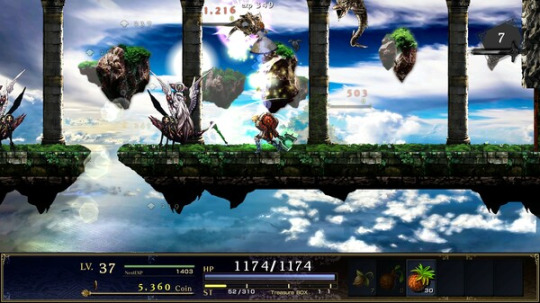
Simple interactions such as buying an item from a shop have been complicated, requiring you to have the appropriate materials on hand to purchase them, keeping you on the lookout for new drops from enemies, or experimenting with the crafting system to see if you can work out the recipe. Grinding these materials will naturally push you into the multiple growth systems, with both a traditional skill point system, but also a sprawling map of character bonuses that can be purchased with gems dropped from enemies. This cartographic journey will unlock more abilities, and ability slots, getting you excited to head right back into combat and keep the loop going.
Combat has the vibes of a later Ys title, if the series had continued following a sidescrolling format. The basic moveset isn't too complicated, with a ground combo, a launcher and spike, and a shield. Early on you'll also get an invincible back dash and magic spells, which enable some strong hit and run tactics. There's a varied arsenal to collect, and while they generally don't have significant moveset changes, considerations like range, attack speed and the unique skills you gain from mastering them keep weapons in rotation even as you progress.
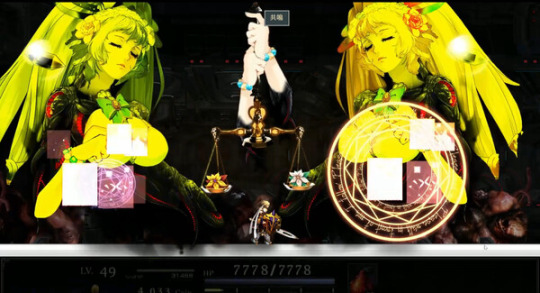
Positioning plays a huge part in combat, and the small cooldowns when your shield breaks, or your backdash ends can end with fatal damage if you're caught in the wrong group of enemies. Magic becomes essential here, providing crowd control and the ability to reposition yourself, with invincibility during the duration of the move. Mana builds through combat, empties outside of it, so you're also incentivized to use spells as soon as you're able, since you'll never be able to stockpile it for future battles.
Despite the myriad ways to prevent damage, you'll rarely come out of a battle unscathed, so spending and refreshing resources becomes essential to surviving even basic encounters. Astlibra is unafraid to push you to take advantage of every system, to the point where the very first boss appears nearly unbeatable until you learn every system. It's an ambitious and gutsy choice, one of many that go against conventional wisdom in modern RPG design. Astlibra is full of these, and it’s a true feat that it manages to remain coherent throughout.

A similar sentiment could be said about Astlibra’s aesthetics. Collaged almost entirely from a number of royalty free images and sound sources, Astlibra has a distinct look to it that calls to mind early Playstation games, where digitized imagery began to become popular. Stitching these images into a single world is a feat of its own, and it manages to stay coherent enough that it never draws attention to itself. Part of this is thanks to a group of professional artists, including Vanillaware veteran Shigatake, who provided the character portraits and sprites, and Haku Tatsufuchi, who created the art for the dragon bosses. The music is equally well selected, with a variety of musical styles, but all feeling as appropriate as if they were composed for the game. The most surprising were the tracks for the many emotional moments of Astlibra, which did a fantastic job selling the drama, something hard to do even in games with bespoke soundtracks.
It’s those big character moments that form the core of Astlibra for me. Even as I enjoyed playing with the various systems of the game, all of it remained motivated by my desire to unravel the next mystery, and my impatience for the next plot beat. Astlibra is full of heart, and it was impossible for me not to be charmed by it.
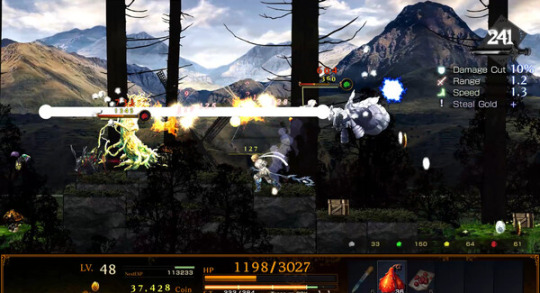
When you spend so many years working on a single thing, it’s hard not to lose faith in what you’re making, and harder to keep a coherent vision as you and the world around you continue to change. Despite the odds, Astlibra manages to hit on every aspect it tries for. It’s a triumph that kept me astounded at what a single person could accomplish.
9 notes
·
View notes
Text
Loddlenaut: a cozy clean up that leaves the bigger questions behind

by Amr (@siegarettes)
Loddlenaut
Developers - Moon Lagoon
Publisher - Secret Mode
PC,
With a chill, and I daresay--cozy--atmosphere, Loddlenaut offers exactly the kind of laid back routine that’s easy to dip into for small moments of satisfaction. Taking the role of an ocean sanitation worker, there’s an immediate satisfaction to clearing the junk and gunk in the area, which builds towards the long term goal of creating a clear, inhabitable biome. Loddles, the native lifeform of the planet, provide a light pet raising element, not unlike Sonic Adventure’s Chao Gardens.
Alongside the cute, slightly aliased aesthetic, and some light survival game elements, Loddlenaut kept me plenty engaged and doesn’t overstay its welcome, with plenty smaller goals for those looking for more. Yet it's those same cozy elements, and the vague gestures toward an environmental message that Loddlenaut struggles to square away.

Loddlenaut follows a familiar structure, starting you out with limited capabilities, clearing areas to reveal the next, and in the process gaining access to new materials and faster, more efficient abilities. Intentional or not, this turns the world into a “frontier”, where wildlife and environmental resources become stepping stones to greater control over the space.
Loddlenaut attempts to sidestep these issues by focusing on restoring an environment that was already previously inhabited, cleaning up the mess left by a careless corporation that exploited the planet’s resources. Materials are simply reclaimed from debris left behind, and it’s restoring the habitats of the plant and animal life that provides resources, not harvesting them. But it’s difficult to throw off the underlying motivations that drive its progression.
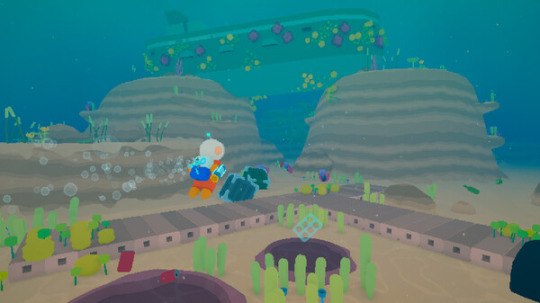
Systems like fast travel emphasize this struggle, only allowing you to quickly travel between areas after you’ve cleared them, and consequently, reclaimed all their materials. The framing is slightly different, but functionally it feels no different to clearing all the objectives in an open world game. The feeling is exasperated in the late game, where the amount of trash increases, and the limited inventory pushes against your ability to make steady progress. The goal quickly became gathering materials to ease the tedium, and more than a few times I considered jettisoning trash back into the area instead of lugging it back to base, so I could clear more of an area before making a return trip. (Dropped trash doesn’t count against an area’s completion). I ultimately didn’t, but looking at the forums it seems that I wasn’t the only one with that idea.
The story gestures towards larger environmental concerns, but never resolves. Your operator makes repeated comments about the massive damage done by the corporation that’s hired you for cleanup, but reassures you that it’s not your job to question your actions, only clean up after them. The delivery had me almost sure that there’d be a turn somewhere near the end, but Loddlenaut concludes with a simple “nature is healing”, creating an unintentional downer ending as I left knowing the underlying problem creating the pollution hadn’t been dealt with.

The team’s intentions seem more to imply that the work is not yet done, to avoid a simple easy solution, and inspire further action, but it leaves so many underlying assumptions unchallenged in an attempt for a feel good ending. I walked away feeling less like my character had made a meaningful contribution, but instead was doomed to be a janitor for the messes of a corporation who would continue to move to new worlds and leave the same problems behind.
I ended up returning to Loddlenaut after the ending, wanting to clear up the areas that had become polluted again in my absence, and to check up and name the Loddles that I hadn’t had time for as I barrelled through the last areas. The little creatures remained cute as ever, but I couldn’t help notice the eerie stillness of the planet. Without the pollution cluttering up the landscape, it had the vibe of an aquarium. An isolated space to raise pets, with sunken structures to add visual variety.
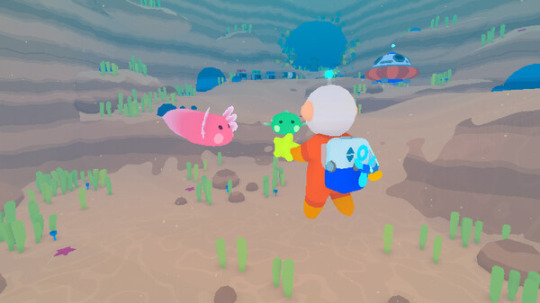
The thing is, as an aquarium, it’s easy to find joy in. At the end of the day I do love to feed and raise my pets, and clean the gunk out of their tank. Loddlenaut is just that, a playground for your pets that I enjoyed, that gestures at the bigger questions without any answers for them.
30 notes
·
View notes
Text
Gunhead Review
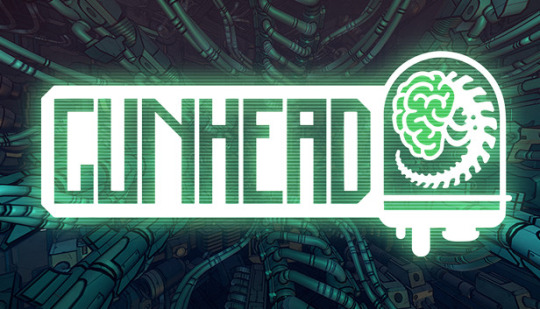
by Amr (@siegarettes)
Gunhead
Developers - Alien Trap
Publisher - Alien Trap
PC, PS5
Armed to the teeth with a shotgun, chaingun, mortar launcher and pile bunker--one weapon for each of my mech’s four arms--and with a cloak in reserve, I was equipped with the perfect loadout for big hit and run damage. The job in front of me was simple: plenty of locked doors on this ship, but with easy access to its door system it would be a non-issue, giving me a straight shot to the shield system and just enough time to splatter the brains of the craft and shut it down. The only major obstacle was the nuke system, which would set off a short range nuclear explosion when a system went down. Dismantle that and the rest was easy.
I slipped in through an airlock, took out the drones still active in the area, then shutdown the nuke system--only to be caught off guard by a slowly radiating explosion that took off several chunks of armor before driving me to retreat into a corner. In my arrogance I'd overlooked the redundancy system, which took over the nuke system the instant it shut down. The time I'd lost from my retreat gave the shuffle system enough time to activate, moving every system to a new room, and ruining my entire plan.
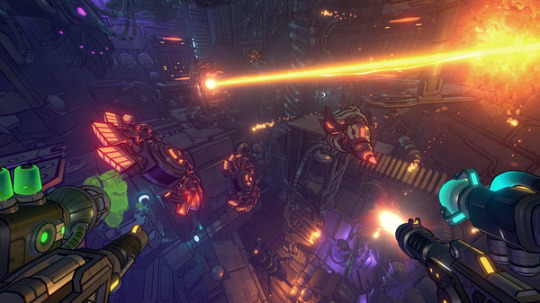
Gunhead is a great generator for stories like this. Every stage is a miniature heist in a claustrophobic space station, taking down system after system to work your way to the squishy brains of the craft. And like a great heist story, there’s plenty of pleasure in seeing a plan come together, but the real stories are the ones where something goes wrong--where a small overlooked detail causes a chain of disasters, or your own arrogance puts you in a situation you should have never been in.
The 3D follow up to Alien Trap’s action roguelite Cryptark, Gunhead follows your small crew as you do jobs for The Corporation, pouring over blueprints, making plans and attempting to salvage what you can out of abandoned space stations. Play cautious and careful and you generally get out with a few scrapes and a decent haul of new weapons and items. So of course The Corporation offers big bonuses to make sure you do anything but that, and makes sure to berate you when you fail to achieve them.
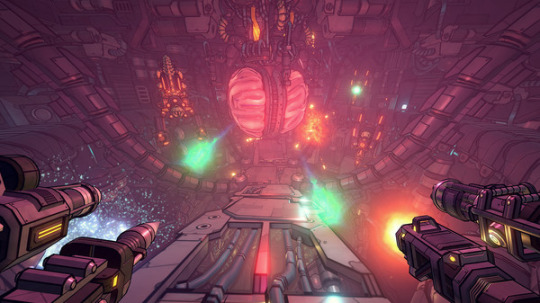
To breach these ships you’ll hop into one of a few mechs, each with their own armaments and traversal abilities. The default has a decent blaster and a jetpack that recharges quickly, while others might exchange some armor for unlimited jetpack use, a grappling hook or load up on the armor and forget the jetpack entirely, opting for a few double jumps instead. Universal to all are the four armed weapon system, allowing you to quickly rain fire on a target when fully equipped. One of my favorite combinations was an explosive and projectile weapon on the main arms, with a grappling hook and pile bunker, allowing me to inflict big damage with hit and run tactics.
Unless you have big cash reserves, you’ll rarely be going in with your ideal loadout. Operations are subject to the luck of the draw, and while you can purchase certain weapons ahead of time, it’s not feasible to do for every run, meaning you’ll be improvising with whatever weapons and powerups you can find on the ship.

The loop of planning and improvisation is the central joy of Gunhead. Satisfying weaponry and traversal are plenty common in roguelites, but the time spent on the map screen adds back a bit of the cerebral elements often cut from action roguelikes, and introduces a more immediate sense of short and long term planning to the mix. It plays well with the narrative framework, giving each level the sense that it’s another day on the job, but also a tense situation that can possibly lose thousands of dollars in assets that your team needs to keep themselves afloat. Progress IS inevitable, but success isn’t--at least not for anyone but The Corporation.
The narrative isn’t a strong presence in the game, but it is surprisingly good flavor. I often find myself quickly exhausted with quippy crew members in other games, but Gunhead’s writing and voice performances are just enough to keep the crew endearing, and not annoying. The Corporation continually watches and evaluates your every move, and the contrast between their dialogue and the crew fills in enough to suggest a greater world.

The snappy pace of Gunhead, and the ability to save between stages kept me constantly revisiting it. It became a great companion for short breaks, with plenty of natural stopping points to keep the intense bouts of action from becoming fatiguing. It understands the strengths of the roguelite format, plays to them, and pairs them with action that is satisfying and dynamic, doled out at a great pace with slowly rising tension. It’s a confident game about getting in, getting out, and leaving a hell of mess for someone else to clean up.
0 notes
Text
Air Twister Review
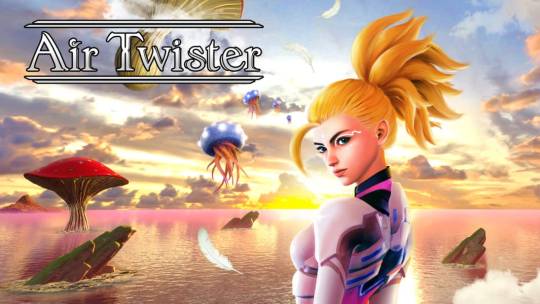
by Amr (@siegarettes)
Air Twister
Developers - YS Net
Publisher - ININ Games
PC, PS5, PS4, XBOX, Switch
The latest from legendary SEGA arcade creator Yu Suzuki, Air Twister has finally escaped its exclusivity period with Apple Arcade and arrived on other platforms. From a glance it's clear that Suzuki and his team were aiming to create a follow up to Space Harrier, with surreal visuals and saturated colors that'd feel right at home in SEGA's fantasy worlds. Scored by Dutch composer Valensia, doing his best Queen impression, Air Twister makes a splashy first impression despite the clearly limited budget. But as the game continues it's clear that Suzuki's vision lacks any real cohesion, rendered in hasty sketches rather than the efficient and masterful strokes of his work at SEGA.

The longer the game goes the more assets repeat, without concrete themes to tie them together. The dynamic camera evokes the sweeping vistas of Panzer Dragoon and company, but environments come off as more as a set of prefabs that line a rollercoaster ride, without any idle animation, with even the water being static.
All of this was only obvious to me thanks to the languid pace of the game. Enemies sweep lethargically into the screen, and bullets are so slow enemies have often left before they can hit you.
The lock on system is translated directly from how it worked on iOS, lacking a targeting cursor, and requiring you to trace enemies with your character before hitting the fire button, which doubles as your rapid fire button. It works counter to genre conventions, removing the tension between rapidly pelting enemies with weaker fire or delaying your shots for a more powerful homing attack.
There's also no cool down between homing shots, so often the best way to deal damage is to slam the attack button, which will launch both rapid and homing shots at the same time. Curiously, you can aim your attacks at an angle with the right stick, but without a cursor it's highly inaccurate, and the tutorial doesn't even bother telling you about it.
It's all sloppy and ill considered, and the soundtrack follows suit . With a full album worth of new and existing tracks and a level progression completely on rails, Air Twister had everything lined up for a perfectly synced score. Instead it continually repeats songs, despite having enough songs to give each stage its own theme. Songs clash with the visuals instead of complementing them, adding to that sense of an incoherent whole.

If there is a consistent theme to Air Twister, it's that repitition, which ultimately what drags it down. Every run is forced to start from the beginning, keeping the game stuck at that initial sleepy pace before it picks up at the halfway point.
Variety only comes through navigating the Adventure Map, a convoluted map structured like a skill tree, where each node requires a certain amount of points earned during runs. Most rewards are either a slight boost to your health or the number of enemies you can lock onto, both which start at a beyond generous amount, or slight variations on customization items like makeup or hair styles. It takes nearly an hour to earn meaningful rewards, which is maybe for the best, since the first weapon I unlocked basically gave me unlimited screen clearing bombs.

The PC version has no meaningful interface changes, making basic navigation a pain. To take the aforementioned Adventure Map as an example, unlocking nodes requires you to either hold down a mouse button for an extended time, or tediously hover over and confirm each node with a controller, with no options to simply click a node further down the path and automatically unlock previous points. The navigation language isn't consistent either, with options like costume changes confirming if you simply hover over them. It's a shoddy and confusing mess, optimized for neither controller nor mouse.
Air Twister, simply put, is kind of a mess. It's not an unlikeable one, and at times it's even fun. But for the most of its runtime the experience is one of humming boredom, punctuated by confusion.
2 notes
·
View notes
Text
Trepang 2 is FEAR for the creepypasta generation

by Amr (@siegarettes)
Trepang2
Developers - Trepang Studios
Publisher - Team 17
PC, PS5, Xbox
When Monolith’s FEAR hit the scene in 2005, it astounded with its sharp AI opponents, technical achievements and blend of slow motion gunplay and J-Horror atmosphere. Even now there’s a particular appeal to that first game, with the two sequels tossing away its unique atmosphere and gunplay for something more conventional. And with Monolith stuck working on whatever license Warner Bros. assigns them, it seemed that nothing would even attempt to achieve the same alchemy that defined the first FEAR entry.
That is, until Trepang 2. Trepang immediately makes it clear where its influences lie. From the way bullets tear through scenery, to the oversharpened look of the slow motion, the enemies’ ragdoll reactions to melee attacks, and the way shotguns instantly pulp bodies, Trepang’s entire aesthetic is directly pulled from the first FEAR game. Even mechanical choices, like the lack of aiming down the sights and the particular feedback of the guns, reflect the very specific gunplay dynamics of the original game and the era it was made in. Some modern conveniences keep Trepang from becoming a complete throwback, but its modern influences are most felt in the works of horror it draws from.
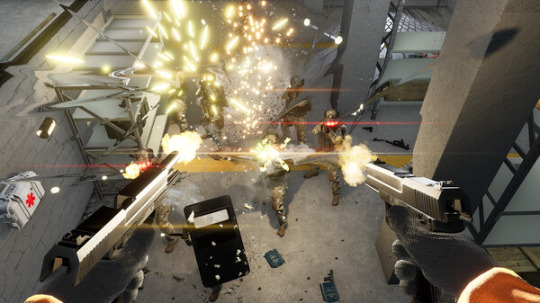
Where FEAR drew on the J-Horror wave sparked by movies like RING and Ju-On, Trepang is rooted firmly in the halls of internet horror. Cryptids and creepypasta lurk in the world of Trepang, and find yourself unlucky enough and you may even take a trip to the Backrooms. By far the strongest influence here is the SCP Foundation’s wiki based meta fiction, which chronicles attempts by a shadowy foundation to contain and document various anomalies causing a wide range of bizarre effects. Different documents across the world reflect the typical format various authors use across the SCP wiki, going as far as using the term “anomaly” in a directly analogous way, with the Syndicate your character works for having similar stated goals and a formidable paramilitary force.
SCP entries and creepypasta are known for being deeply variable in their quality thanks to the open format, and this is something that Trepang unfortunately inherits. The wide well of influences it draws on ends with a scattershot atmosphere. It opens with you fighting cryptids and bioweapons, before focusing in on the wider corporate conspiracy, leaving only side missions to explore the horror side. Even then it’s sporadic, with some missions being little more than combat arenas, and some laying on everything from cheap jumpscares and bad stealth, to genuinely unnerving and atmospheric moments.

It’s in the commitment to the alchemy of horror and action that Trepang 2 most disappoints. It simply can’t make up its mind on what it’s trying to achieve, and shoots in too many directions to make an impact. Given more breathing room, it might have had time to explore all of these, but its main campaign is comprised of only a few missions, over in a compact few hours, with many threads left underexplored. Side missions and combat simulator leave plenty of action to return to, but the story leaves a hurried impression, especially with its last hour revelations and sudden conclusion. It’s a world that’s sketched out more than suggested, and even with all the supplementary material you never get a real sense of the how or why. And not in the classic horror ambiguity way.
Thankfully, a lot of Trepang 2’s narrative failings are easy to forget when engaged in its sharp combat. Trepang keeps surprisingly faithful to the original FEAR and its era specific quirks, meaning there’s no aiming down the sights to slow down the action, with only scoped weapons allowing you to zoom in. Combined with the gunfire, smoke and debris tearing up the battlefield, every engagement is chaotic and blisteringly fast. The stimulation is borderline excessive, made manageable by the ability to slip into slow motion to track enemy positions and line up precision shots. Quick melee attacks supplement the gunplay, with the most crucial move being the slide, which acts as both a method to escape and knock down enemies for a quick execution.

The stealth mechanics are underbaked, but mostly serve as a way to silently take down a few enemies for an advantage before a fight, or escape under fire. My favorite addition has to be the ability to take unaware or stunned enemies hostage, using them as a shield, instantly killing them, or tossing them into a crowd while pulling the pin on their explosives, turning them into a free grenade.
Combined, the moveset allows an explosive hit and run play style, weaving in and out of gunfire, then sneaking out with your cloak to appear at your next victim’s flank. Damage is high enough that even at full health and armor it only takes a few seconds under fire to get yourself killed, so even with this massive advantage you’ll need to make smart tactical decisions to survive.
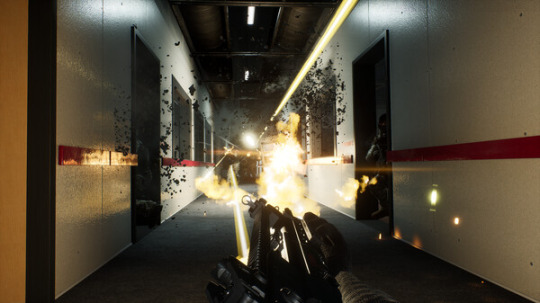
With a massive suite of arena missions and a recently added survival mode that strings multiple arenas together, there’s a huge amount of challenges to keep digging into in the post-game. I’d definitely like to see more full sized, directed level designs, since that’s where the combat shines best, but what’s here provides plenty until the inevitable future DLC.
Trepang 2 isn’t quite the FEAR successor that I envisioned, never hitting the same highs of combat or atmosphere as the original game, but even Monolith couldn’t pull it off twice. Instead Trepang 2 forges its own identity, taking those ideas that inspired it, and bringing them forward for a new generation to enjoy.
3 notes
·
View notes
Text
Grid Force brings an ambitious new take of the Battle Network style
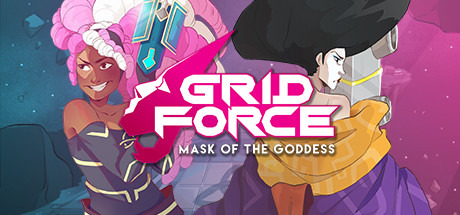
by Amr (@siegarettes)
Grid Force: Mask of the Goddess
Developers - Taito, Pyramid, M2
Publisher - Square Enix
Switch, PS4
Self-described as a "tactical bullet-hell RPG", Grid Force is in reality a Mega Man Battle Network style game. Presented with visual novel style branching dialogue and illustrated comic panels, it immediately impresses, and continues to do so as the scale of what it's attempting is revealed. Grid Force is unafraid to reinterpret the core ideas of its inspiration, with arenas that vary drastically, and a large roster of playable characters that shake up the way battles play out on every screen. Unfortunately, Grid Force's ambitions often overreach, leaving the execution of its many ideas inconsistent through its runtime.
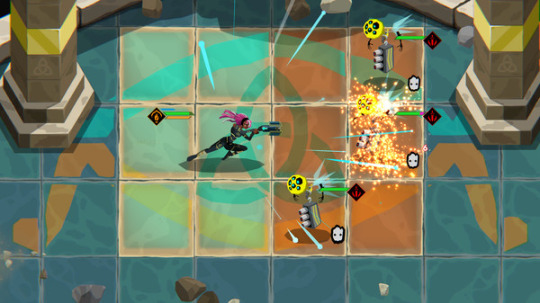
Grid Force's initial visual impact is quickly lost in messy visual language, and confusing design choices. I had plenty of favorites across its cast--which admirably attempts to include a diverse range of races, body types and play styles--but was sadly kind of mixed on the designs overall. In attempting to represent such a broad range of cultures, Grid Force sometimes plays with a cultural shorthand, with designs that feel more like they're meant to tell you what the character represents, more than anything about the character themselves. Unfortunately, this does include members of the main cast, who get the most screen time in the story.
Their in-game representations don't flatter the characters either. Grid Force uses one of the weaker implementations of cut-out style animation, with broad movements that lack the finesse and details that generally make the style work. Attacks lack impact or strong posing, making it harder to read in the chaos of combat.

Readability is a huge issue in general. The grid uses a combination of 2D and pseudo-3D hitboxes. Targeted attacks land within marked spaces, giving clear indications of where the end of their arcs are, but other attacks can collide with the entire 2D space they occupy, even if they seem to be at a "depth" that's in front or behind a character. A shot might hit a larger character in the head instead of passing "behind" them on the tile above, for example. It generally works in the player's favor, and is at least internally consistent, but mixes visual rules in a way that's unintuitive.
Layered on top of this is the class, armor and elemental systems, which can swing the direction of battle wildly. Damage output can be near zero if attacking with the wrong element or attack type, and you can quickly be one-shot if hit with your elemental weakness. Conversely battles can be a breeze if you go in with the right character. With luck, or a little precognition, you can finish battles near instantly. The first boss fight dragged on, but when I made it to the second, I happened to have a character on my team that annihilated the boss on the first try.

Elemental weaknesses can be hard to parse, too. A small symbol delineates an enemy element, but they vary with class type, leaving only the color to communicate the element. Elemental weaknesses aren't always intuitive either, with interactions like dark beating water, or air beating earth. I found myself constantly glancing into the pause menu to check the weakness order, although unfortunately there isn't a way to do the same for your team's attributes.
The obfuscation continues to the leveling system, which seems to keep characters perpetually underleveled. After each battle a random set of shards are dropped, each corresponding to an element, and each of those elements increasing a certain attribute. (These also need to be picked up before advancing to the next area, so you can lose resources if you're not careful).
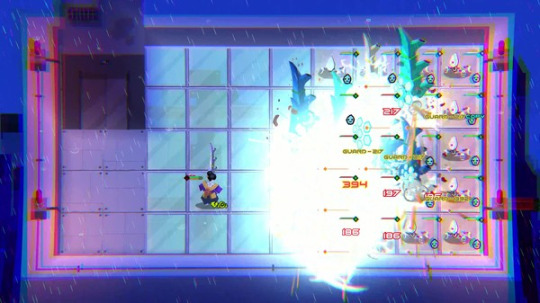
Each attribute has a certain number of tiers that contribute to stat growth, and additionally work together to affect your primary stats like hit points and mana points, as well as earn you the next character ability. With each tier the requirements for the next one go up exponentially, making it cheap to bring up the initial tiers, and expensive to continue improving. Cost seems to vary by character as well, with characters having affinities for certain elements, making you work if you want to improve them in areas that they're not naturally aligned to.
I see the intent behind the system--which would in theory make leveling up more considered and keep pushing you towards certain builds rather than a more generalized approach--but in practice the scarcity and randomized nature of resources meant I threw points into whatever areas I could afford to level up, just to keep up with enemies and work towards the utility of new abilities.
Grid Force is full of odd designs like this, attempting ambitious ideas that don't land. But when it hits, it hits.

Even with its many issues, when you get everything lined up Grid Force feels GOOD. Synergizing abilities to take advantage of the various grid designs, setting up the right team composition, and parrying enemy attacks makes the tactical layer engaging. Working out how to stagger an enemy for big damage is rewarding, and giving the enemy the ability to parry your attacks keeps you from treating it as a DPS race where you can keep firing without consideration. The core systems here shine with the right team, and while it can drag when you’re not prepared, there’s an intense back and forth to boss encounters that makes them engaging even on a repeat encounter. To the point where I was surprised that Grid Force didn’t have any multiplayer options, as it felt suited for it.
The combat loop kept me around even when grinding my new team members up to my current power level, because I was happy to see how much better I could do this time around.

And this is a game that you’ll want to dip into for repeat playthroughs. Not only to see the other story paths, or unlock characters you missed the first time, but because it’s built into the thematic framework of the story itself. Grid Force is a game about continuing to struggle, together, against a world that’s hell bent on entropy and your destruction. It’s about cycles of suffering and what we can endure before you finally achieve the world that we want. And like other parts of the game, sometimes it’s attempting to pull a little more weight than it can carry. I found it hard to relate to some characters, and the story often tries for a heavy atmosphere before giving you a proper idea of what the stakes really are.
Grid Force takes on a lot of ideas, and only manages to see a few to a complete, refined state. But the few it achieves this with are excellent, and give it a unique, standout identity. Of the recent games in this style it’s easily my favorite, with such a variety of characters, personalities and mechanics that I’d love to see it expanded on and refined. Grid Force is taking on a lot more than it can handle, but that makes it hard not to root for its success.

0 notes
Text
My favorite ways to play GBA

by Amr (@siegarettes)
The GBA is one of my all time favorite consoles. With an iconic, pocketable form factor and an expansive library of games, I’m still finding ways to enjoy it, over twenty years after its release. And with so many different options to revisit that library, it can be easy to get wrapped up in finding the “perfect” way to play it. But the truth is, so much of the handheld experience is wrapped up in the hardware you play it on, that the best option is going to be different for each person.
So today I’m going to run through my favorite ways to play GBA, why I picked them, and what makes each great.
***

Before you start whipping out your wallet, look around your room, check your drawers, or dig through your garage and see if you’ve got a DS Lite hanging around.
This was my GBA standby for years, and it still remains a great option. With a great clamshell design, rechargeable batteries, a built-in backlight, and perfect compatibility thanks to its built-in GBA hardware, it’s an accessible and fuss-free way to revisit old titles. As a bonus it plays, ya know, DS games.
Audio output is clean, if a little bit low volume at times, but that can be fixed by pairing it with the right earbuds. The only real downsides are the aging hardware can make it a little harder to find good condition units, and the older screen and slightly higher resolution mean there’s slight ghosting and the image won’t fill the screen without stretching.
The DS might not have the fidelity of modern options, but it’s an off the shelf solution with nearly every feature you’d want, with minor compromise and zero setup.
***
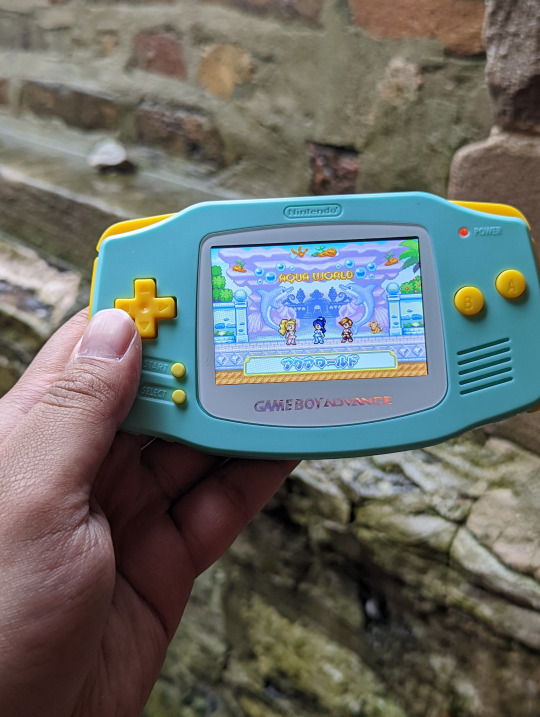
If you want something closer to the original experience, a modded GBA can’t be beat. I prefer an original model GBA, since it’s less cramped than the SP. With a new lens and an IPS screen, and custom shells, you can get a unit looking nearly like new, with an image that easily outdoes the DS, and of course, has perfect compatibility and integer scaling.
The biggest drawback is by far the price. The components for modding are reasonable alone, but quickly add up, especially if you want options like rechargeable batteries, or a fix to the noisy GBA headphone jack. Power consumption rapidly becomes an issue as you add additional mods, or use a flashcart. At one point I thought I had bricked my console, but it turned out the combination of the increased power usage of my flashcart combined with the new screen was simply drawing more power than the depleted batteries could put out.
Even with those hassles and drawbacks, when I need that uncompromised, perfect compatibility, this is my personal favorite way to play GBA. Modern screens might give an experience closer to emulation than slightly blurred, washed out colors of unmodified hardware, but it looks so good it’s hard to make a fuss about it.
If you’re lucky to live in a place where you can access professional modding services, through Etsy, eBay or otherwise, you can buy a pre-modded GBA for not too much more than it’d cost to build it yourself, and save yourself the anxiety of trying not to break anything in the process.
I got mine from Gamechanger Mods in New York. They’ve got tons of fantastic custom colorways, and Greg was prompt and quick in making adjustments and sending the unit back and forth. Honestly, it was easily worth what I paid for it, but it’s difficult to recommend this option for anyone other than the most particular players.
***
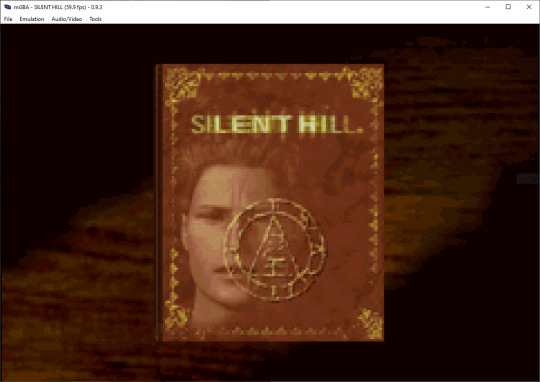
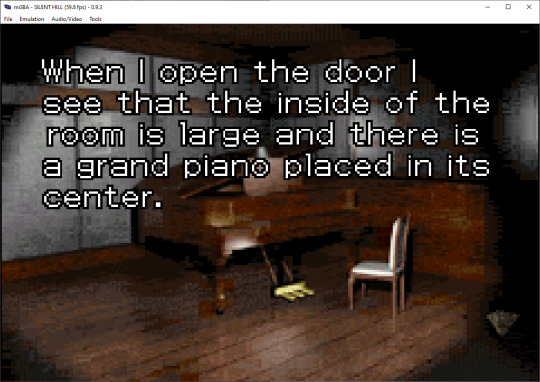
For people not going for original hardware, emulation is the easiest and best option. There’s a bit of a preconception that emulation is inherently and noticeably worse, but with over 20 years of emulator development, emulation has progressed to the point where, with the right hardware and software, it’s near indistinguishable from the real thing. The process itself introduces some inherent latency, but unless you’re playing a rhythm game or you’re a speedrunner attempting frame perfect tricks, you probably won’t notice. In return you get an incredible suite of features and flexibility.
For my money, mGBA is hands down the best out there, with incredible accuracy and robust features that I didn’t even know I wanted. Tuned correctly, performance was even consistent enough for me to play games with tight timing, like Rhythm Heaven. It can’t make me good at them though.
I do have to shout out VisualBoy Advance though, which hit early and paved the way for a lot of future efforts. I was legit emulating games as I kept current with physical releases, thanks to VBA.
***
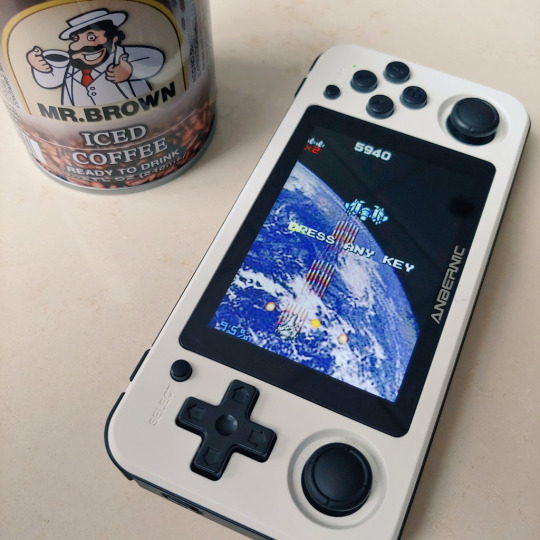
When I need a pocketable GBA emulator, to me the Anbernic 351P is the only option. The 351P has just enough power to run mGBA smoothly, with low latency, and just as importantly, has a screen that matches the GBA’s 3:2 aspect ratio, at a perfect 2X integer scale. Basically no other portable emulator can say that.
The shoulder buttons are similar to those on a GBA SP, but with microswitches and landscape form factor closer to the original GBA, as well as a good dpad, four responsive face buttons, dual analog sticks that click in, secondary shoulder buttons, and a rotary volume wheel.
The same factors that made it ideal for GBA compromise the other systems it can play, but it’s generally still adequate otherwise. On top of accurate emulation, you can even configure it for save states, rewind and fast forward, and remap the controls as you please, which is a godsend in difficult action games like Mega Man Zero.
The biggest problem is how much work you have to do to get it up and running. It’s not even worth using the stock firmware, and you might as well throw away the SD card it ships with, leaving you to flash a custom OS and load up your own SD card with ROMs, if you want it to meet what I’d consider the minimum standard for emulation. No matter what firmware you go with, you’ll be stuck with Retroarch, which is a miserable hassle to navigate, even after you get over the learning curve.
Quality control is hit and miss too. My first unit had its headphone jack come loose through regular use, and the replacement I was sent had the same issue, even after I took extreme care with it. I ended up opening it up and resoldering the joints myself to repair it, which should NOT be a required step.
Personally, the 351P is still by far the best portable emulator in terms of features, form factor and price, but it’s up to you if all that work is actually worth it.
***

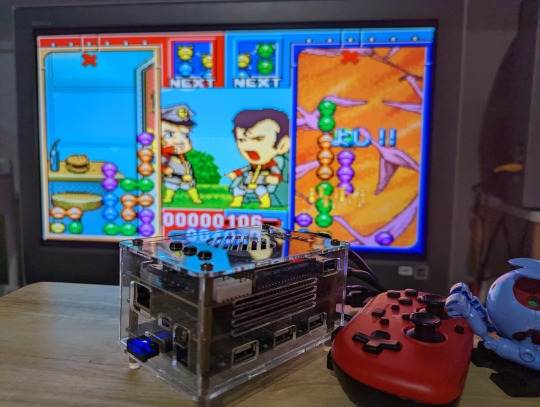
Now if price is no issue, and you somehow don’t care about portable play, the MiSTer project offers an incredible suite of alternatives to emulation. While software emulation still has it beat in flexibility, accessibility and diversity of options, a lot of the common conveniences are here, bolstered by an FPGA solution that emulates the system at a hardware level. It’s probably one of the most accurate ways to play GBA, barring original hardware, and still cheaper than trying to get a GBA Player running on modern screen, or modding a GBA into console form.
There’s a lot to love in the MiSTer’s GBA core--from the infinite controller choices, micro adjustments you can make to the display and sound options, and even support for the same rewind, fast forward and save states you’d get elsewhere.
By far my favorite feature is the 2 player GBA core. It’s a bit of a pain to import and edit save data, but it’s otherwise one of the fastest ways to get GBA multiplayer up and running, without the need for two systems, carts or link cables. There are so many ways to display the two screens, including outputting the second player to a separate screen. It opened up the possibility to easily play a lot of the multiplayer modes I’d never had the chance to check out.
I legit brought my MiSTer to my local fighting game meetup and played loads of multiplayer GBA games, some for the first time. We tried everything from Sonic Battle to competitive Mega Man Battle Network. All with our own controllers or arcade sticks.
***
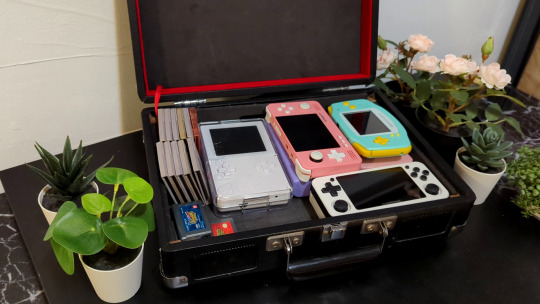
And those are all my favorite ways to play GBA!
Each of these are great options, but don’t get wrapped in thinking they’re the only choices.
Regardless of which way you choose to play the GBA, there’s an incredible library to dig into, with ways to personalize the experience to fit exactly the life you’re living.
The important part is to get out there, and play the damn games.
12 notes
·
View notes
Text
The Retroid Pocket 2+ Experience: Flawed, Frustrating, and Fun
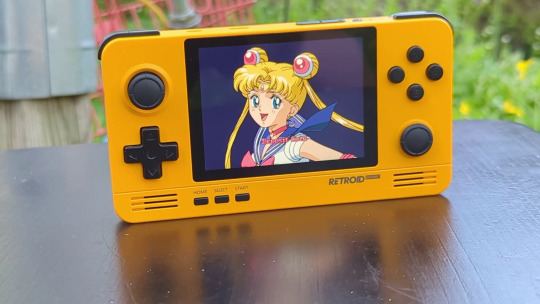
by Amr (@siegarettes)
Retroid Pocket 2+
$100 via Retroid, $150 via Amazon
Android based emulation of whatever systems you can load onto it, up to the Dreamcast
Emulation handhelds sell an incredible promise. Multiple generations of consoles and handhelds, all on a single device , with a unified control scheme and the added features of years of emulation development. But more often than not, these devices are a bundle of compromises with features packed in no matter if they make sense.
The Retroid Pocket 2+ initially seems to be exactly that--an incremental upgrade for a sub 100 dollar device, reusing the same shell and awkward controls,running on an outdated version of Android. No matter how you cut it, any modern Android smartphone with a decent USB controller is going to outpace it in performance. So it better offer some other compelling reasons to pick it up.
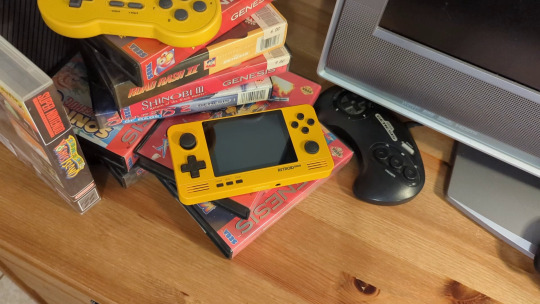
Before we start, I want to note that this isn't a comprehensive overview, or technical deep dive. There are others who've already done that better than I can, and have thoroughly tested emulation performance with a variety of systems and games. Any metrics I put out would likely be outdated by the time I put out this review, anyhow.
Instead I'll be looking at the device's practicality,and how enjoyable it is to play games on, based on my own personal experiences and preferences.
We'll find out what, if anything, kept me playing this thing for three months, instead of putting it down and picking up a more powerful device instead.
Let's get this out of the way first: despite improved buttons, an added touch screen, and a significant power boost, the 2+ is still held back by the controls it inherits from its predecessor.
The Retroid Pocket 2+ uses the same Switch style buttons and sticks, but the cramped layout means they lack the offset d'pad and button placement. To prevent the right stick from interfering with the face buttons, they've shortened it into an analog nub, that technically offers analog control, but is clumsy and stiff enough that it's not useful for anything requiring precision. And trying to operate it in tandem with the left stick and shoulder buttons results in awkward and painful hand gymnastics.

That left analog stick, by the way, isn't recessed at all, causing it to snag on sleeves and pockets.The function buttons are also crammed awkwardly together near the bottom, with no real space to separate them. The raised profile generally makes it possible to differentiate them by feel, but I've definitely quit a game accidentally when I meant to pause.
Its saving grace are stacked shoulder buttons and upgraded button switches. Stacked shoulder buttons are still sadly uncommon in this space, especially in this price range and size, and it makes it much easier to access all the controls on systems like the Playstation. Retroid has also replaced the switches on the d'pad and buttons, making buttons easier to press, and reducing fatigue over long periods.
The addition of a touchscreen is very welcome, since operating Android without one on the original Pocket 2 was a nightmare. It's one of those features that should have been included to start with. Though I do have to mention it's not great for touch heavy games,even if there are ways to side step that.
I bought the original Pocket 2 nearly two years ago, being the best performing device in the sub $100 range. Emulation performance was...barely passable. There was a lot that *technically* ran but wasn't enjoyable to play, and it struggled more than I thought it would with certain 2D games. 3D was laughably out of the question.

For me to say that something runs well, I expect it to play full speed, with no major hitches, without frameskip and consistent frame pacing. It should work more or less as well as original hardware, with minimal tinkering, and adjustments only necessary for enhancements. I enjoy the process of tinkering and dialing in my personal settings, but putting in half an hour or more just to get a game running isn't worth my time. At that point I might as well shove a monitor into my bag and set up the original console each time I want to play a game.
The original Retroid Pocket 2 fell short of every one of those expectations. Still, it was good enough for me to finish half the Mega Man X games,and throw on some shorter games and ROM hacks to kill time between tasks or travel.
The Retroid Pocket 2+ is, in short, what the original should have been with to start. Performance is finally what you'd expect out of a device in this range, with highly accurate emulators for 2D systems running at full speed, without frameskip, and 3D games are a lot more feasible on the device.
Dreamcast is the highlight of the device, with the 480p screen being a perfect match for the Dreamcast's VGA output, and the limitations of the controls being a good match, aside from the lack of analog triggers. My initial tests were done with the Redream standalone emulator, which I found frustrating and limited, but after switching to Flycast almost every game worked with little to no tweaking. And games that had issues ironically ended up working in Redream.
Playstation is at a point where it's basically plug and play, which means I can set aside my PSP and Vita as my go-tos for portable Playstation games, which before this held their spot for a decade and a half. The added convenience of being able to straight up load ISOs through an SD card or USB C cable, without going through the eboot conversion process, on top of the general quality of life improvements brought by the Duckstation emulator has resulted in me playing Playstation a lot more regularly.
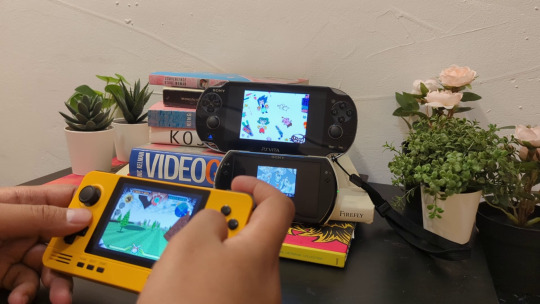
Speaking of portable Playstation, PSP apparently has wide compatibility on the Pocket 2+. I say apparently, because I've only tested a few games, to see if it worked for the purpose of this review.I might not use my Vita or PSP for PS1 emulation anymore, but nothing beats original hardware in terms of controls and ease of play.The PSP already has a built in sleep mode, so it's just as simple to pick up and put down, and 4:3 aspect ratio of the 2+, while a great fit for a majority of older consoles, is a poor fit for the PSP's widescreen presentation. With letterboxing the effective screen size of PSP games is 8.5cm, down by 2cm from the already cramped screen of the PSP Go, which stands at 10.5cm. It works in a pinch, but I'm not that desperate to have everything on one device.
Likewise, GBA games run great, but make a poor fit for the screen. The 3:2 aspect ratio doesn't lose as much in terms of letterboxing the image, but the resolution means you'll be choosing from a miniscule 1x scale image, or uneven scaling and applying filters to interpolate or blur the uneven pixels. Again, it's passable, and the extra buttons might even offer some advantages in creating custom control schemes for titles more limited by the GBA's original hardware, but at this point I'm so spoiled for good choices I'm not willing to compromise there.
Returning to the SEGA side of things, Saturn emulation is a nice bonus when it works.My initial setup seemed to black screen on a majority of games, but reinstalling the app after updating the emulator and Retroid firmware, suddenly plenty more games were playable. Some games still just don't work at all, or have severe sound or sync problems, but enough of them do more or less run with minimal tweaks. Save states and other features are still a bit buggy, but that's more a problem with the relative difficulty of Saturn emulation.
N64 emulation has likewise always struggled with emulation, thanks to the major ways that it differs from the standard architecture computers use today. Performance was initially so miserable that I gave up on it. Even after spending a half hour or more on single games, and following the several community settings guides, I could not get them to run at an acceptable level.I nearly wrote this review with a recommendation that you skip it entirely.
But once again, a major update made several more games playable out the box, or with one or two tweaks. The Pocket 2+ still isn't powerful enough to approximate the N64's image processing features, so there's a rough, inaccurate quality to it--but if you're lucky you can play through certain games with no major issues. I have no idea what makes a game playable or not--I've had Tetris of all games stutter and drop inputs, while hacks like Smash Remix play relatively fine.

For both N64 and Saturn you'll also be bottlenecked by the limits of the original consoles themselves. A lot of these games ran like GARBAGE on original hardware, so accurate emulation would technically replicate that. Some games can potentially run faster if they were designed for uncapped framerates, but in a lot of cases this'll either run the game too fast or make emulation even more unstable.
Another problem is that Saturn and N64 controllers use layouts different from the current standard, so unless you've got a controller with six face buttons, you'll either be using a compromised, awkward universal control scheme, or making custom controller profiles for every game. N64 games that use the whole controller are genuinely painful to play on this.
Oh and before you let anyone convince you that this thing plays PS2 or Gamecube games--it doesn't. Sure, you can get select games to a barely playable state with a lot of work, but even for simpler titles I've had to run them with a lot of frameskip, often at half the original resolution, to get them to play at a smooth frame rate.
There are community compiled lists with "ideal" settings, but even when working with those I was spending more time tweaking settings than playing the games, and I felt my time was better spent playing any of the thousands of other games on this device that run without problems.
Even with emulation for those two systems improving every day, you're better off looking at a device with more power that will be able to take advantage of them.

That said, the experience IS improving. As I've alluded to a few times,the Retroid Pocket 2+ has seen its share of updates. Not only to the included emulators, which have been updated independently by their authors, but for the device itself and the included custom game and app launcher.
Since I received my unit, there have been two updates, the major 1.8 update and a smaller 1.9 update. The former added updated software and custom configurations for emulators that made a lot of games more playable out of the box, as well as addressing complaints people had with the launch software. The 1.9 update likewise aimed at complaints about the launcher, adding in navigation features that further smoothed out the experience. Importantly, these updates are delivered "over the air", meaning you can download and install them directly via wifi, without needing another device.
As for the custom launcher itself, it's a weird mix of design languages imitating both the Switch UI and Emulation Station. Standalone Android apps are organized into a way too small 2x2 grid, and emulators are in a single row tile view, not unlike the Switch. Neither of these are comfortable to use, personally, and as of writing, only app tiles can be reorganized--in a very clunky way--and emulation tiles are stuck in the order you've added them. Meaning if you want to reorganize you have to remove and add them again, possibly losing settings in the process.
The whole thing is honestly missing a lot of features you'd expect to be the baseline, and the original version of this software was even more lacking, missing options to add consoles like the MEGA DRIVE even though they had entries for systems like Gamecube that this device isn't suited for at all.
But importantly, while I wouldn't consider this a good experience yet, Retroid has shown a willingness to take feedback, incorporated suggestions into their updates, and delivered those updates at a reasonable timeframe. Handhelds like this rarely get any long term support, generally leaving the community to improve on the experience, so it's rare to see major, actually useful updates from the developers themselves. Those initial problems I've mentioned have already been addressed, with other unexpected improvements that genuinely made my experience measurably better.
Features like being able to launch a game with a specific Retroarch core OR standalone emulator, the ability to get the checksum of the file for better game database matches, and the immediate inclusion of relevant emulators in the initial install--all make it easier to get up and running sooner.
There's even handheld specific options to tweak options for Xbox or Switch style controller layouts, how the screen behaves when connected to an external display, assigning buttons to touch controls, or quickly enabling and disabling Google Play to eke out a little more performance.
It won't make emulation plug and play, but it's clear Retroid are making efforts to make the process as simple as possible.
And if you don't like the way they chose to handle features or presentation, because this is an Android device you can sidestep it completely. Other gaming front ends exist with different navigation styles and aesthetics, or you can do what I do and stick mainly to the regular Android UI.
Now, given that I'm basically using it as a low powered Android device, it's worth returning to the question: why bother with this instead of paying the same price--or less--and taking advantage of the powerful hardware already on the very phone I'm filming this with?

Well, never to be one to resist a frivolous purchase, I did exactly that, for comparison's sake. What I found confirmed a lot of assumptions I'd made. The most immediate difference is how easily my Pixel 6 powered through every system that gave me trouble on the Retroid, and the controller I used provided a more comfortable and ergonomic layout.
Systems like the Playstation weren't even a challenge, and I could easily push 3-4x native resolution--probably more if my phone's display could display it. Gamecube and Wii games were a bit less steady, but this has as much to do with mobile specific emulation issues as it did the complexity of the games. Still, I was able to run games like Sin and Punishment: Star Successor, which have TONS going on all the time, at 2x resolution, with basically no slowdown outside the places they'd lose frames on actual hardware.
Even older games are improved, with the BSNES and mGBA cores able to output perspective corrected, high definition textures for games that use Mode 7 style scaling.
And naturally, this setup works great for native Android games, something that the Retroid can struggle with, even when it has enough power, thanks to incompatibilities with how each game adapts to the aspect ratio and low resolution.
So again, why bother? Part of it has to do with the current ecosystem of phones, one that makes it simply more practical to have a different device. Phones might be absurdly thin now, but the wide dimensions a lot of them use means that with a controller they're impractical for pocket gaming, let alone other everyday functions. Imagine trying to call, text or pay the train fare on a Nintendo Switch, and that's basically the experience you're getting. As if the spirit of the NGage possesed your phone. No, more often you'll be assembling and disassembling it whenever you wanna play games, which is a hassle in its own way. The 2+ has its own annoyances, but it's much simpler to pocket.
With the 2+ I won't be burning through the battery of the device I rely on for every day tasks either. Even on a phone with a good battery, gaming eats up a ton of energy, and a gaming session is naturally going to end up limiting the time you have to text, call, look up directions, or even pay for things, if you use a digital wallet. When that battery drops below 30% forget about games. There's no way I'm risking access to all that to play games.
By comparison, I never worry about the 2+. The 2+'s battery has lasted for DAYS, even up to a week, without charging, with regular use. Even at 10% or less I found there would be plenty of juice left to get in an hour of gaming on my commute home. It was actually hard to get an accurate idea of how long the battery would last, because before it ran out I'd want to add another game or app to it, and inadvertently end up charging it in the process.
Phones have also been trending towards non-expandable storage and removing the headphone jack. Any games you add to your phone will immediately be competing with space for other apps and media. Putting just a fraction of my Retroid's SD card on my phone had me immediately needing to clear out space, since I already use it to shoot video and listen to music.
Oh and on the subject of headphone jacks allow me to go on an oldhead rant about how that's one of my least favorite trends in tech. Wireless headphones seem like a great convenience, until you have to worry about dead batteries or switching between devices. It doesn't seem like a big deal, but being forced into the headphone jack free life did make me reconsider which combinations of gadgets and headphones were practical to carry with me.
Thankfully, the Retroid has both a standard headphone jack, and pretty good Bluetooth. Again, doesn't seem like a big deal, but it meant that I could keep both the Pocket and my phone connected to wireless headphones,and seamlessly switch between them if I needed to take a call, listen to music, or look something up.The 2+ even stays connected when you put it to sleep, and automatically connects to my headphones when I power them on, which puts it ahead of the Switch in that respect.
Bluetooth seems to work better with wireless controllers than on my phone, so if you're one of those sickos that always has a controller on them you can whip it out and use the 2+ as some kind of mini console. About the only time I had an issue with Bluetooth was during Saturn emulation, where it was clear emulation performance was causing audio lag.
And if I need to switch devices quickly, take it along with older devices, or power headphones that need some more OOMPH, the headphone jack is there. Ya know, it seems weird to explain why I bother with a HEADPHONE JACK but people do genuinely ask me why I care.
Screenwise, the low resolution, squared off aspect ratio may initially seem to be a compromise, but make the 2+ more suitable for older games. Everything up to the Dreamcast era was more or less designed with 4:3 screens in mind, meaning even if you stick with integer scaling you'll often get a picture that fills out the entirety of the 2+'s screen. By comparison, the ultrawide ratio of my phone means an effective screen size that is either the same or SMALLER than the 2+, but with pillarboxes nearly as large as the image itself. Most games before the Xbox 360 maxed out at 480p or lower as well, so compared to original hardware the 2+'s screen is as sharp or sharper than native quality.
The numbers work out a little differently for the 2+'s TV output. A micro-HDMI port keeps the USB-C port free for charging, or additional controllers and accessories, but you'll be seeing the same standard definition resolution, upscaled by your display so you can pick out every visible flaw. And while the Retroid's screen itself is 640x480, the output from HDMI is a slightly strange 720x480. As far as I can tell this mostly results in a slightly wider Android UI and NOT stretched pixels in game, but I don't have the hardware to test it properly. At least when comparing the in-game image to the Retroid's display simultaneously, they seem to line up.
Most widescreen displays should display the 2+ perfectly OK, with results varying depending on how your screen handles upscaling. My computer monitors all display the output fine, in relatively crisp quality, but on my 4K TV it looks like GARBAGE.
(Honestly, I don't know why an oldhead like me even owns one, it basically just makes everything I don't play in 4K look worse, which is most games for me these days.)
Oh and while we're getting into niche and hyper-specific situations, depending on your display's options, the 720x640 resolution WILL mess with your attempts to connect it to a 4:3 monitor without uneven pixel scaling.
Even with this mountain of caveats, I still enjoyed the jury-rigged setup of using the 2+, connected to a TV, and even sometimes an external controller and power supply if needed.
If you really wanna push more impractical setups, you could probably set up a USB hub and connect some controllers to play 4-player Super Bomberman or something. At that point I imagine it might start impacting performance, but nothing's stopping you.
That sort of describes the Retroid Pocket 2+ on the whole. There are tons of situations it works great for, and plenty more where it's unreasonable to expect a good result. But it'll still let you try.

Practice runs of Shinobi 3, Star Fox 2 with a Super FX overclock, sneaking in rounds of Cosmic Smash on transit, catching up on fan translations and hacks, and creating a setup to easily switch to tate mode for arcade shooters--the 2+ has been flexible enough to pull off every one of these. I even got my word processor working as a Bluetooth keyboard to play Typing of the Dead. And I've got a long list of other games and ridiculous ideas I'm looking forward to trying out.
Emulation handhelds are as much about the platform they provide as the device itself. In a world full of RGB mods, boutique cables, upscalers, linedoublers, FPGA hardware, ODEs,modded consoles and endlessly evolving emulation, it can be easy to get focused on finding the BEST solution for playing every single game in your library. But at the end of the day, the one that gets you to just sit down and play the games is the best one.
Even as someone with a million hyper specific, incredible options, the Retroid Pocket 2+ was what did that for me. For some situations there are still other devices I'd pick over this one, but on most days, when I just wanted to play some games, the 2+ was my go to.
It's a machine constantly grinding against its limits, full of frustrations and some outright bad design decisions--but it plays the damn games, and often enough, plays them well. Right now, that's acceptable, but with so many obvious flaws it's easy to imagine something making it immediately redundant within a year or so.
But for the last few months I can genuinely say that I've enjoyed games more, and finished many I wouldn't have had time to sit down and play. So until the next big thing, I'll be enjoying all the time for gaming the Retroid 2+ has given back to me.
1 note
·
View note
Text
The Analogue Pocket Experience: A Beautiful, Overengineered, and Disappointing GameBoy
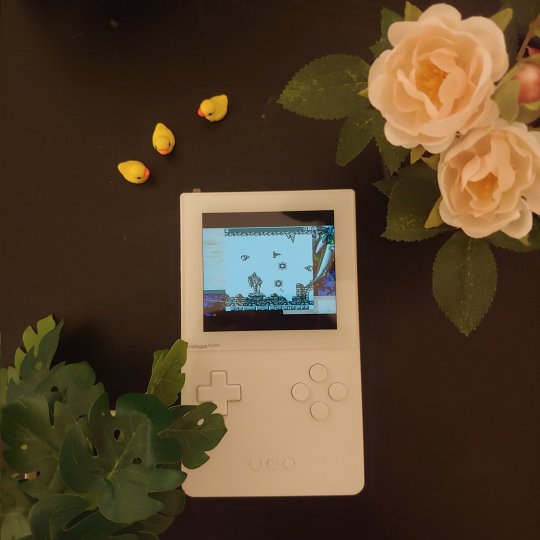
by Amr (@siegarettes)
Analogue Pocket
$220 for the Pocket, $100 for the Dock
Plays original GameBoy, Color, and Advance carts. Additional adaptors allow you to play Game Gear carts and (ostensibly) Lynx and Neo Geo Pocket in the future
After a long period of big promises, delays and drama, the Analogue Pocket is finally here. An HD, portable solution for playing GameBoy games (and possibly more), the console seems to have made big waves in the retro scenes. On paper, it seems like everything you’d want out a modern GameBoy, and more. But how does it hold up as an actual portable, meant for everyday use? After four months with the Pocket, I’m here to tell you what the Analogue Pocket experience does, and doesn’t deliver, with some comparisons to other devices before the final verdict.
Before we start, let’s go over what the Pocket promises, and what my expectations were for it.
Going from Analogue’s own site, the Pocket supports Gameboy, Gameboy Color, and Gameboy Advance games, as well as the Game Gear, Neo Geo Pocket and Atari Lynx in a high definition display. It’s features display modes that imitate the original hardware, save states, sleep and wake functions, multiplayer with the Pocket and original Gameboy hardware, on board Nanoloop music tracker software and support for GB Studio homebrew titles, optional external dock support, and more with the upcoming Analogue OS updates. Sounds good.
As for my own expectations, I want my portables to be something I slip into a jacket or pants pocket, pick and put down at a moment's notice, and fit into spaces during my commute or downtime. For context, my commute is over an hour each way, with plenty of time between stops to sneak in a quick game.
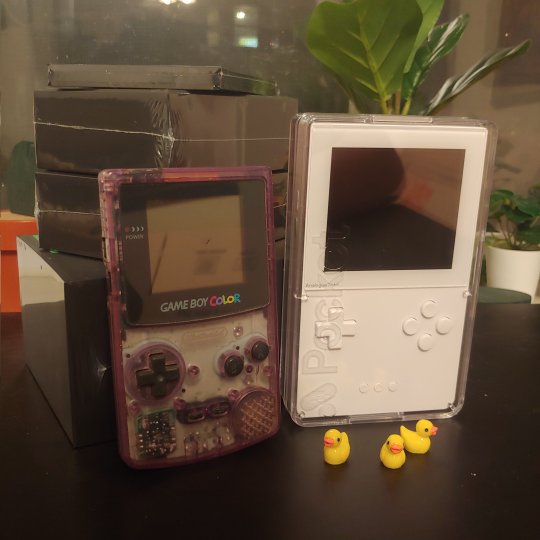
Before I even got to the hardware the Pocket was off to a bad start. Opening up the optional (30USD) clear case, I nearly broke the tabs immediately because I put it together the wrong way. The small pegs on the bottom half clearly slot into the holes on the back of the Pocket, but what I didn’t realize is that the top half also only goes in one way, and putting it on wrong caused the tabs to catch unpleasantly, giving me anxiety for the next ten minutes as I attempted to remove the Pocket without breaking the case. To be fair, I probably would have known all this if I’d read the included manual first, but what kind of case requires a manual to operate?
I bring this up because it kind of reflects Analogue’s approach to hardware. The whole package feels designed by people who design hardware to be displayed, not directly interacted with. The Pocket itself has a sleek, minimalist design that’s popular with tech geeks and modders, imitating the original Gameboy hardware, but jettisoning the welcoming, toy-like curves for sharp, crisp edges in a monochrome color scheme.The shoulder buttons a bit higher than halfway on the back, next to the cartridge slot. It splits the difference between an original DMG and the SP, not unlike the unhinged GBA SP mod.
What it doesn’t take from the SP is the location of the cartridge slot, opting for the original Gameboy cartridge placement, which immediately causes problems. This compromise turns the already cramped layout of the SP more uncomfortable. With the SP you can mitigate this by hitting the shoulder buttons with the inside of your knuckle, but here the cartridge blocks that and causes your fingers to rest on the cartridge while playing. To keep the shoulder buttons accessible, the cartridge slot is left more exposed, which holds fine for GBA carts but leaves Gameboy and Gameboy Color carts loose and easily jostled with a light tap. Which seems like a good way to lose save data.

It ends up being a worse solution than both the original Gameboy and SP form factors, breaking compatibility with games like Boktai, where it blocks the solar sensor. Unfortunately, that’s probably also the only way they were going to be able to get cartridge adaptors for other systems positioned reasonably, which were going to look ugly no matter what.
With such weird, compromised hardware, it shouldn't be a surprise that games on the Analogue reflect that.
My first run at the device was with a GBA flashcart, which I'd been playing mostly through my DS. Like the DS, the mismatched resolution means dealing with a letterboxed image, but GBA games appear bright and crisp otherwise. The aforementioned hardware issues immediately get in the way, especially for games that make heavy use of the shoulder buttons (MMZ), though the option to mirror the shoulder buttons on the upper face buttons somewhat mitigates it.
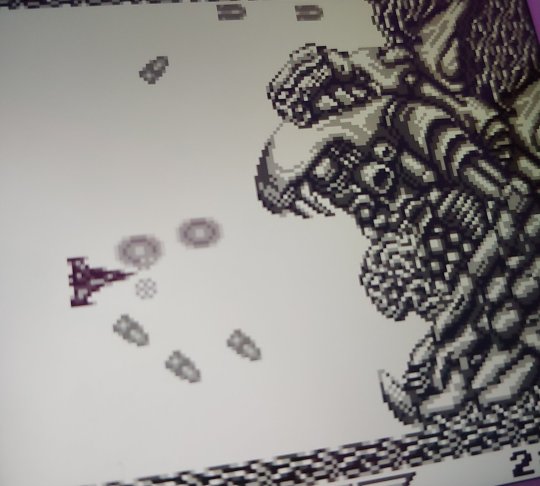
What really causes problems are the subtle incompatibilities with flashcarts. Flashcarts are a popular method for anyone wanting to play original hardware, since you don't need to deal with carrying a load of carts, or pay exorbitant prices to check out a system's library. Officially, the Analogue doesn't support loading ROMs either (we'll get back to that one), so you'll likely want one.
Even after several updates, some users are still reporting flashcarts not working entirely, which I've luckily avoided. Either way, using a flashcart will lock you out of the system's save state and sleep functions, which is a big hit to the Analogue Pocket's portability, but wouldn't be a big problem if they didn't cause the flashcart's own sleep and save state functions to malfunction.
Something about the way Analogue handles the cart has caused problems when returning to original hardware, including data being erased entirely, and save states made on one device being incompatible with the other.


On the subject of save states, the Analogue nominally supports them on a system wide basis, but as of writing, months into the device's release, you can only write a singular save across ALL games. Creating a save in one game will erase your save in the other. For GBA games this isn't much of a problem, but it becomes a problem for GameBoy and Color games, which often either used passwords to save progress, or had no way to save at all.
Eventually, I was able to dig out one of the Gameboy carts I did have, which finally made the system make sense. The crisp, full screen display, alternative screen modes, and even the awkward button layout all fell into place when playing, and having sleep mode y'know, actually work, made it a much better fit for portable play. As a premium upgrade to the original GameBoy and GameBoy Color, the Analogue Pocket finally made sense, and even competes with modern options for modded hardware.
Well, for a little while. Like almost everything on this system, the more I played it the more details fell out of place. The power and volume buttons immediately became a problem on my commute. The original GameBoy models all use either a volume wheel or slider, with satisfying action that let you intuitively understand where you are on the volume scale, and what the maximum and minimum are. The Analogue Pocket uses ovaloid buttons, with the split volume button doing double duty, allowing you to also adjust brightness or mute the system by pressing both halves at once.

The size and shape of the button makes them both easy to mistake for each other, and hard to hit a specific button. I needed to use a fingernail to adjust volume, and I found myself constantly turning the system to make sure I was hitting the correct button, so I wouldn't accidentally mute it, or put it into sleep mode.
The on-screen display also only shows if you're going up, down, or have reached the minimum or maximum, with no indication of where you are on the scale, all displayed in white text with no outline. You might be able to guess why that could be a problem on a system designed for playing black and white games.
Sleep mode's implementation is remarkably inconsistent, too. A short tap of the power button will put the system into sleep mode, but only if you're playing an original cart or GB Studio game. On flashcart it'll prompt you to power off the system entirely, and when on the menu, without a game loaded, sleep mode is disabled entirely. It's way too contextual, going against muscle memory for a button that's had a consistent function across almost every device for decades. At least a long press will always turn off the system.
Issues like this go on and on--there's only a few preset color schemes, with no way to mix them with the screen filters, and no custom color scheme support yet, giving you less options than an original GameBoy Color. Buttons can't be remapped, with only an option for a SNES style layout that switches the main controls to Y and B, mimicking the Super GameBoy’s alternate control scheme. This outright replaced the option to mirror the buttons to the shoulders button, which came with the original firmware. No idea why it couldn’t keep both. . And no, there isn't support for Super GameBoy color palettes or borders, if you're wondering.
What's bewildering about these issues is they're all issues that have been solved on emulators, FPGA solutions like the MiSTer and handhelds that cost half of what the Analogue goes for. They're basic features I basically expect out of both hardware and software.
The extra features it touts would theoretically go some way to make up the gap, but all these are equally half baked or MIA. Community developed cores, which would allow it to play other systems (somehow, without playing ROMS), don't even have an option in menu, with no mention or news on them outside the initial announcement.
There’s no hint of an unofficial jailbreak, which usually releases within a week of Analogue devices, providing at least the ability to play ROMs. Nor is there any sign of the Analogue OS, which promises the ability to save screenshots, have multiple save states, and organize playlists of your favorite games (again, somehow, without playing ROMs).
The only cartridge adaptor available now is Game Gear adaptor, with nothing on the promised Lynx and Neo Geo Pocket adaptors, and reports that the Game Gear one might even be damaging the labels on carts.

GB Studio support is less than impressive, thanks to it requiring the proprietary .pocket format, which only GB Studio 3 can export to, causing compatibility with the majority of homebrew software made with GB Studio, which were primarily made with older versions. To be fair, this is a software issue out of Analogue's control, and the community have developed branches of previous GB Studio programs that can export to the new format. Of course, this would also be solved if the Analogue Pocket just played ROMs.
Ironically, GB Studio support has been getting a lot of use--as a workaround to play GameBoy and GameBoy Color ROMs. A lot of people speculated that the proprietary format the system uses was just a wrapper for GameBoy ROMs, so Analogue could continue to claim the system doesn't play ROMs. That seems to be at least partially true, with IPS patches coming out that allow you to convert GameBoy, GameBoy Color, and even more ironically, GB Studio games, to a format the Analogue Pocket can play.
This has, at the very least, allowed me to play the majority of GameBoy titles I'd wanted to play on original hardware, letting me discover new favorites and kept me from dropping even more on a GameBoy flashcart to play the titles I couldn't on my GBA cart. It's definitely an added bonus, though this has all been thanks to community efforts, so I can't exactly give Analogue any credit for it.
And even after all that, with how many disappointments the Pocket lays on, the Dock might even be more disappointing. The Dock has thankfully been updated with the ability to update straight from the Pocket, use original screen filters, resize the screen, and adjust saturation, all of which it launched without.. That said, controller support is still limited, and the link cable port is blocked when docked, since they placed it on the bottom. It doesn’t have the promised CRT output via the Analogue DAC, making it neither analog nor pocketable.
Compared to the care taken with displaying GameBoy and GameBoy Color games on the Pocket, the Dock feels like an afterthought whose purpose is primarily to offload the cost of Bluetooth and USB-C display out to another device. Sure, compared to the cost of niche solutions like the GBA Consolizer it comes out well ahead, but if you don't care about continuing progress from the same cart, suddenly you have plenty of better options.

If you're married to the benefits of FPGA devices, a fully kitted out MiSTer costs less than the price of the Pocket, the two flashcarts, and dock you'd need to play the Gameboys' libraries, and gets you tons of options for screen modes, filters, color palettes, controllers, analog video, Super Gameboy palette and border support, working save states and even 2 player local play, on the same or separate screens, for all generations of GameBoys, on top of tons of consoles, handhelds, arcade boards and old PCs made before the Playstation generation.

If it has to be a handheld, portable emulators are rapidly improving, and for the same price as the Pocket itself, or even less, you can find a handheld capable of running the most accurate Gameboy emulators, with low latency and HDMI output, and support for everything up to the Dreamcast, as long as you're willing to do a little work.
And if you're willing to really work for it, well you can probably play everything the Pocket does on the very device you're reading this on. If you're accepting a compromise already, why not accept a compromise that gets you more?

To justify itself in such a crowded space, the Analogue Pocket needed to do a single thing better than anything else. Its high resolution, perfectly integer scaled, backlit screen almost accomplishes this for the GameBoy and GameBoy Color, but in the process strips the experience of the charm and portability of the original systems, while compromising every other feature it promises. I set my Analogue Pocket in plain view every day, ready to be packed up and played on my commute, but I found myself increasingly picking up other systems instead. The 3DS XL, my emulation handhelds, the even more clunky Switch, and even the original, non backlit GameBoys--each of them provided a more compelling experience than the Pocket, and fit better into my lifestyle.
The Analogue Pocket is a system that asked me to change my routine to fit its design, rather than being designed to fit into my routine. It's a beautiful, over engineered device that feels like an unfinished first draft for a revision that'll never come. It's a fantastic display piece, but if you want to actually play the games, you've got better options.
6 notes
·
View notes
Text
Dimension Tripper Neptune Short Review

by Amr (@siegarettes)
Every once in a while Neptunia will draw me in with a new premise, something that promises to break up the monotony of the main line games. Like Superdimension Neptunia vs. SEGA Hard Girls, Dimension Tripper Neptune does this by drawing on the appeal of SEGA properties, this time with taking after SEGA’s Space Harrier. Sadly, the resemblance is only superficial, and the comparison once again doesn’t work in Neptune’s favor.
Running for about the same length as SEGA’s Space Harrier, Dimension Tripper Neptune lacks any of the intensity or character that made SEGA’s sprite based 3D arcade game memorable. The scrolling is smooth, the colors are intense, and it’s fantastic to see pixel art renditions of Neptunia enemies, but none of the characters really take advantage of the 3D effect, or provide interesting patterns. It makes for a game that’s visually intense, but unexciting to play.
Dimension Tripper Neptune rarely requires any precision movement or shooting, and even the final boss’ more complicated patterns can be avoided entirely, rather than forcing you to weave through them. Even the addition of a melee move doesn't add much to the action.
Dimension Tripper is just too insubstantial to hold your attention for more than the 15 minute runtime. Even the scoring mechanics are too simple to return too, leaving this as little more than a novelty for the franchise.
0 notes
Link
On today's episode we talk about all kinds of niche hardware, both new and old, as well as advocate for some new survival horror hybrid games--with bodacious goth witches.
Oh, and Amr complete fucking loses it and tells you ever damn thing wrong with the Analogue Pocket.
1 note
·
View note
Text
Metroid Dread makes big gambles that don’t pay off

by Amr (@siegarettes)
With over a decade since the last mainline Metroid or Castlevania game, it’s hard not to notice that MercurySteam has been given the keys to both parts of the Metroidvania namesake. And when looking at their catalog it’s hard not to ask “Why them?”
They opened their career with a series of derivative action games--with a special 3DS entry that has the pleasure of being one of the worst entries in both the series and genre writ large--then moved onto a ramshackle remake of Metroid II. A game that aspiried to make the story of Samus doing genocide into a sick fucking action game.
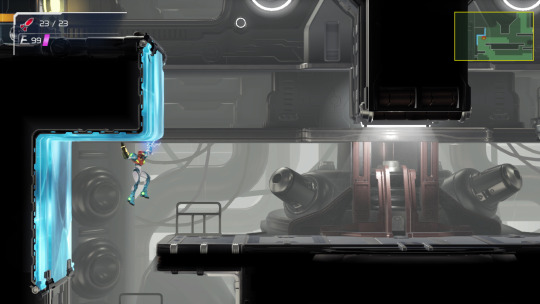
It’s as if someone saw the work that a small studio like Climax did on Assassin’s Creed Chronicles, and went “those are the people we gotta get to do our next big game.” To be fair, that gamble did work out for Shattered Memories.
So here we are again, with MercurySteam left to bring to life yet another long awaited title to life--but this time without the baggage and tonal issuses of Samus Returns.
A decent chunk nto Metroid Dread the gamble still hasn’t paid off. But it doesn’t exactly bust either, leaving us at more of a break even point.

Dread starts out at a sprint, and as long as it keeps its momentum the breathless pace and fluid movement carries it. The array of movement options here makes it fun to simply run around the planet, sliding, grappling and bounding off walls. Later powers let you move even faster, with dramatic effects that make you appreciate the technical effort into making such a seamless experience, on a system where that’s not always a guarantee.
But every time the pace slows, it gave me too much time to reflect on the frustrations that have been accumulating the whole time.
The opening hours of Dread repeatedly force you down one way passages, often collapsing your entrace as it opens a new exit. Meaning you’ll have to go around the long way--through the entire damn section--just to get to where you were standing ten seconds ago. It’s as if they took VVVVVV’s “Veni Vidi Vici” and applied it to the map design of the entire planet.
When you finally find the ability that blows the map open, I found it in an area I’d been frequently discouraged from exploring, past a one block opening I had to pixel hunt for. And this isn’t the only place where progress is going to be blockaded behind some easy to miss clue to a hidden area.

I can see what they’re aiming for. All of this is in service of their biggest gamble--creating a claustrophobic environment that forces you into conflict with the EMMI: ruthless hunting robots that can kill you in a single hit. Which did not work for me at all.
What is supposed to be a tension filled hunt quickly devolves with repetition. EMMI are restricted to certain zones, generally giving them the advantage but letting you escape if you make to an exit undetected.
After fighting a few the pattern becomes routine. Get to a zone, die a few times learning the layout, then come back with some other power that lets you fight the same, unchanged boss once again so you can absorb its energy to power the big gun that will destroy this area’s EMMI and award you a new power.
It’s a cycle that reminds me a bit too much of Samus Return’s rigid structure, and simiply gestures toward the format and tension of Metroid Fusion, without having any of the narrative stakes or atmosphere to back it up.
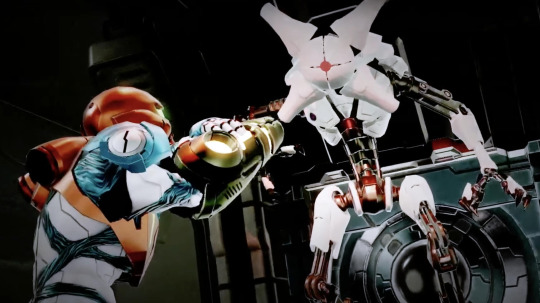
Scratch beneath the surface and it’s easy to see the outlines that make up the color-by-numbers structure filling out this game. But who’s going to complain when the colors are this vibrant? It might be all routine, but for people who’ve been dying to return to routine, this is probably everything they wanted.
Hell, Dread might even turn out to be a good game. But in the time since Samus’ absence the people following in her footsteps have started to outpace her. It’s gonna take a little more than what Dread is bringing to stay in the race.
1 note
·
View note
Text
G-Darius HD Short Review
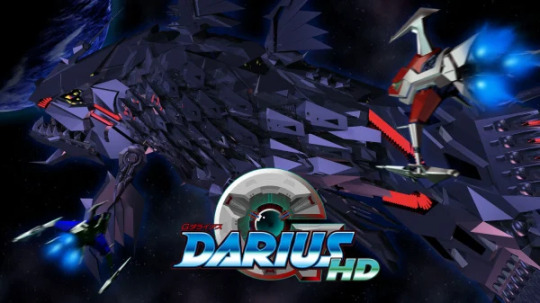
By Amr (@siegarettes)
Dariusburst Another Chronicle EX
Developers - Taito, Pyramid, M2
Publisher - Square Enix
Switch, PS4
“You will see the birth of new lives” with these dramatic words you’re sent off into the cosmic sea of G Darius. Flying through landscapes of oceans, prehistoric forests and psychedelic space, G Darius gives the impression of a struggle against time and evolution. All of this is backed by a score made of distorted vocals, crowd sounds, industrial percussion and swelling choirs that would almost feel at home in a horror game.
The drama comes to a climax with the capture system, which not only allows you to capture enemies for new weapons, but also mini-bosses, with both enabling you to engage in spectacular laser duels with stage bosses.
The only letdown in the package is the HD transfer, which is certainly sharper, but lacks the extensive gadgets found in other M2 releases.
G-Darius may not be the revelation advertised, but its cosmic landscapes still deliver quite the journey.
0 notes
Text
Dariusburst AC EX Short Review
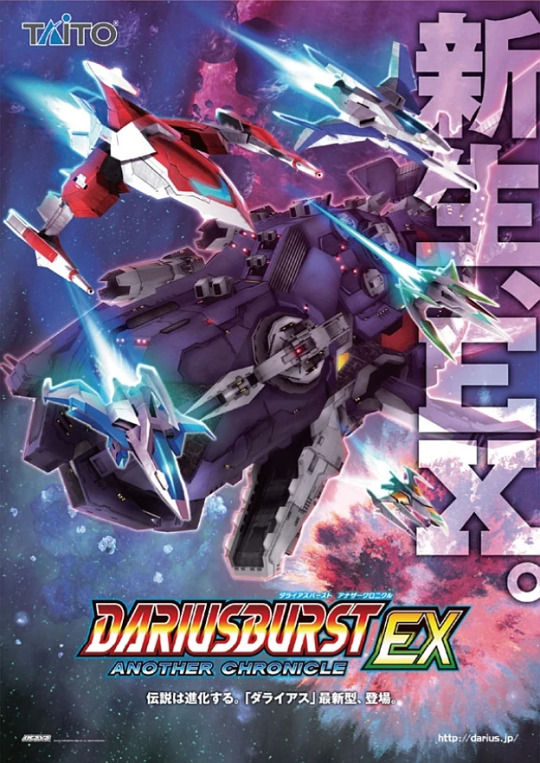
by Amr (@siegarettes)
Dariusburst Another Chronicle EX
Developers - Taito, Pyramid, M2
Publisher - Square Enix
Switch, PS4
Coming from the gluttonous feast that was Chronicle Saviors, Another Chronicle EX is like showing up to a banquet and only being served an appetizer. Chronicle Saviors, the previous port, sported both a port of the ultrawide arcade game as well the titular CS mode, with a brand new campaign formatted for 16:9 widescreen, new songs, and an upgrade system, as well as extensive DLC support with shooter crossovers from other companies.
Another Chronicle EX is more or less a straight, no frills port of the arcade game, with the previously missing event mode restored, and the new ship from Chronicle Saviors added. None of the M2 gadgets have been added, and no concessions have been made for the 16:9 presentation, save a not so useful zoom function.
At almost the same price as Chronicle Saviors, Another Chronicle is charging full admission to eat another party’s leftovers.
0 notes